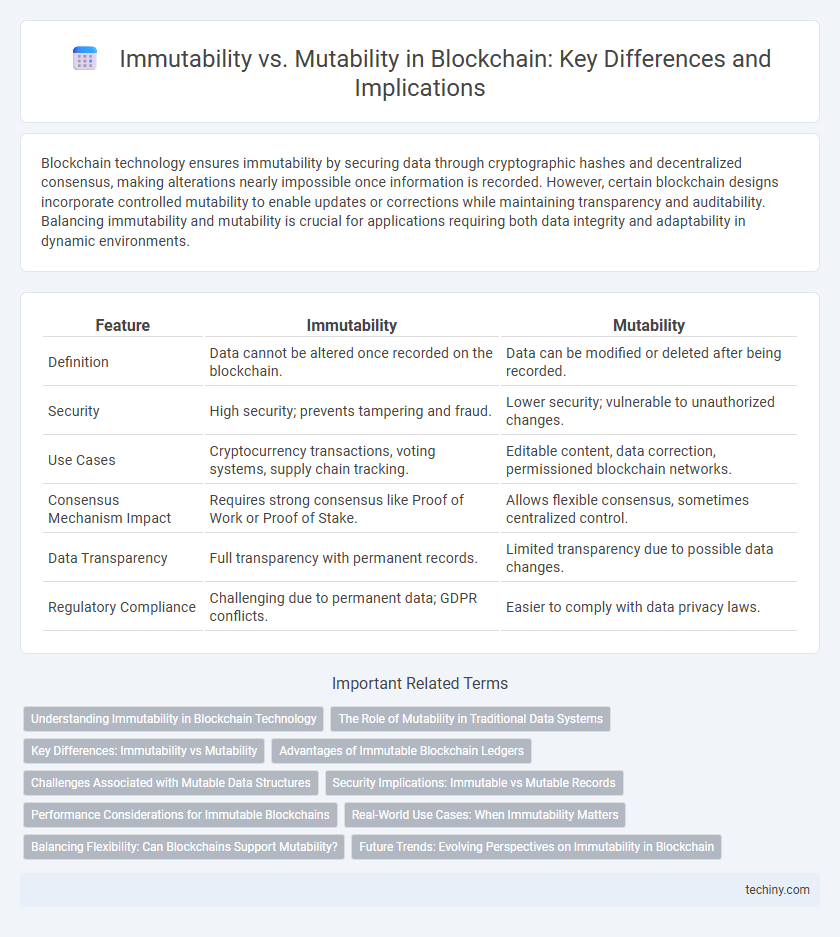Blockchain technology ensures immutability by securing data through cryptographic hashes and decentralized consensus, making alterations nearly impossible once information is recorded. However, certain blockchain designs incorporate controlled mutability to enable updates or corrections while maintaining transparency and auditability. Balancing immutability and mutability is crucial for applications requiring both data integrity and adaptability in dynamic environments.
Table of Comparison
| Feature | Immutability | Mutability |
|---|---|---|
| Definition | Data cannot be altered once recorded on the blockchain. | Data can be modified or deleted after being recorded. |
| Security | High security; prevents tampering and fraud. | Lower security; vulnerable to unauthorized changes. |
| Use Cases | Cryptocurrency transactions, voting systems, supply chain tracking. | Editable content, data correction, permissioned blockchain networks. |
| Consensus Mechanism Impact | Requires strong consensus like Proof of Work or Proof of Stake. | Allows flexible consensus, sometimes centralized control. |
| Data Transparency | Full transparency with permanent records. | Limited transparency due to possible data changes. |
| Regulatory Compliance | Challenging due to permanent data; GDPR conflicts. | Easier to comply with data privacy laws. |
Understanding Immutability in Blockchain Technology
Immutability in blockchain technology ensures that once data is recorded on a distributed ledger, it cannot be altered or deleted, providing a tamper-proof record of transactions. This characteristic is achieved through cryptographic hashing and consensus mechanisms, which validate and secure every block added to the chain. Unlike mutable databases, blockchain's immutability enhances transparency, trust, and security in decentralized systems across industries like finance, supply chain, and healthcare.
The Role of Mutability in Traditional Data Systems
Traditional data systems rely heavily on mutability, allowing data to be modified, deleted, or updated to reflect changing information and correct errors. This flexibility supports dynamic business processes, enabling real-time data adjustments and iterative development cycles crucial for transactional consistency and operational efficiency. However, this mutability introduces vulnerabilities such as data tampering and audit challenges, which blockchain technology addresses through its immutable ledger structure.
Key Differences: Immutability vs Mutability
Immutability in blockchain ensures that once data is recorded, it cannot be altered or deleted, providing a secure and transparent ledger resistant to tampering and fraud. Mutability, on the other hand, allows data modification after recording, which reduces trust and increases vulnerabilities to unauthorized changes. Key differences lie in security, transparency, and data integrity, with immutability guaranteeing permanence, while mutability offers flexibility at the cost of potential data manipulation.
Advantages of Immutable Blockchain Ledgers
Immutable blockchain ledgers provide enhanced security by preventing unauthorized data alterations, ensuring transaction integrity and trustworthiness. This tamper-proof nature supports regulatory compliance and auditability, offering transparent and verifiable records. The permanence of data also reduces risks of fraud and errors, fostering confidence among participants in decentralized networks.
Challenges Associated with Mutable Data Structures
Mutable data structures in blockchain introduce significant challenges, undermining the core principle of immutability essential for trust and security. They increase vulnerability to tampering, complicate audit trails, and hinder consensus mechanisms, leading to potential inconsistencies in the distributed ledger. Ensuring data integrity requires robust protocols to manage changes while maintaining transparency and accountability, which remains a critical obstacle in mutable blockchain implementations.
Security Implications: Immutable vs Mutable Records
Immutable blockchain records ensure data integrity by preventing unauthorized alterations, enhancing security against fraud and tampering attacks. Mutable records, while allowing updates and corrections, introduce vulnerabilities through potential unauthorized modifications, increasing risk of data breaches and compromised trust. Selecting immutability in blockchain architecture is critical for applications demanding high security and verifiable audit trails.
Performance Considerations for Immutable Blockchains
Immutable blockchains enhance data security and trust by preventing any alteration of transaction history, but this immutability often results in slower transaction processing and higher computational costs due to the need for consensus and cryptographic validation. Performance optimization strategies include layer-2 scaling solutions, sharding, and off-chain computations to alleviate throughput limitations while maintaining data integrity. Balancing immutability with efficiency is crucial for blockchain applications requiring both security and high transaction volumes.
Real-World Use Cases: When Immutability Matters
In real-world blockchain applications, immutability ensures transaction records cannot be altered or deleted, providing critical trust and transparency for financial auditing and supply chain provenance. Use cases such as cryptocurrency ledgers, legal contracts, and voting systems rely on immutable data to prevent fraud and enhance security. Conversely, mutable blockchains serve scenarios needing data correction or privacy compliance, but immutability remains essential where trust and irreversibility are paramount.
Balancing Flexibility: Can Blockchains Support Mutability?
Balancing flexibility in blockchains involves exploring controlled mutability mechanisms like soft forks, off-chain solutions, and permissioned ledgers to allow necessary updates while preserving core immutability principles. Techniques such as multi-signature protocols and smart contract upgradeability provide adaptive features without compromising security and transparency. This approach enables blockchains to support evolving requirements in enterprise and regulatory environments while maintaining decentralized trust.
Future Trends: Evolving Perspectives on Immutability in Blockchain
Future trends in blockchain indicate a shift from rigid immutability towards adaptive mutability, enabling selective data modification while preserving auditability. Innovations in layer-two solutions and decentralized governance models promote flexible ledger updates without compromising security or trust. These evolving perspectives balance transparency with regulatory compliance, fostering broader enterprise adoption.
immutability vs mutability Infographic

 techiny.com
techiny.com